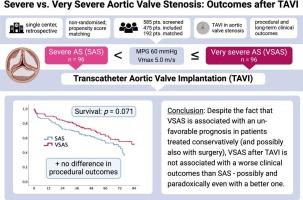Paradoxical clinical outcomes of severe versus very severe aortic valve stenosis after transcatheter aortic valve implantation? a propensity score matched analysis and review of literature
IF 2.5
Q2 CARDIAC & CARDIOVASCULAR SYSTEMS
引用次数: 0
Abstract
Background
Very severe aortic stenosis (VSAS) is a critical condition with unfavourable clinical outcomes if left untreated or treated by surgical valve replacement. In contrast, after transcatheter valve implantation (TAVI) outcomes seem to be similar or – paradoxically – even better compared to severe aortic stenosis (SAS), as indicated by previous studies.
Methods
Data of patients from a single centre who underwent TAVI were retrospectively analysed. Patients with concordant AS (n = 475) were divided into SAS (n = 379) and VSAS (n = 96) groups. These groups are compared in terms of procedural (safety) and long-term (efficacy) outcomes, using propensity score matching. In addition, a review of relevant literature is provided.
Results
After propensity score matching, 96 patients remained in each group. Procedural outcomes did not differ significantly between VSAS and SAS groups. Cox proportional hazards regression analysis showed a favourable trend toward lower overall mortality within a mean follow-up of 42 months after TAVI in the VSAS group (hazard ratio, HR, 0.668; 95 % confidence interval, CI, 0.430–1.038). This difference did not reach statistical significance (p = 0.073), however, it was significant in the subgroups of females (p = 0.045) and patients with NYHA class III (p = 0.043).
Conclusion
Our analysis confirms – in line with previous studies – that patients with VSAS represent a substantial subgroup and have at least as favourable or – paradoxically −even better clinical results after TAVI compared to patients with SAS. Therefore, TAVI should not be withheld from these patients.

经导管主动脉瓣植入术后严重与非常严重主动脉瓣狭窄的矛盾临床结果?倾向评分与文献分析和回顾相匹配
背景:非常严重的主动脉瓣狭窄(VSAS)是一种危重的疾病,如果不及时治疗或进行瓣膜置换术治疗,其临床结果将会非常不利。相比之下,经导管瓣膜植入(TAVI)后的结果似乎与严重主动脉瓣狭窄(SAS)相似,甚至更好,这是矛盾的。方法回顾性分析同一中心接受TAVI治疗的患者资料。合并型AS患者(n = 475)分为SAS组(n = 379)和VSAS组(n = 96)。这些组在程序(安全性)和长期(有效性)结果方面进行比较,使用倾向评分匹配。此外,还对相关文献进行了综述。结果倾向评分匹配后,两组各有96例患者。VSAS组和SAS组的手术结果无显著差异。Cox比例风险回归分析显示,VSAS组TAVI术后平均随访42个月,总体死亡率有降低的趋势(风险比,HR, 0.668;95%置信区间,CI, 0.430-1.038)。差异无统计学意义(p = 0.073),但在女性亚组(p = 0.045)和NYHA III级患者(p = 0.043)中差异有统计学意义。结论:我们的分析证实,与之前的研究一致,VSAS患者代表了一个重要的亚组,与SAS患者相比,TAVI后的临床结果至少是有利的,甚至是更好的。因此,不应该对这些患者隐瞒TAVI。
本文章由计算机程序翻译,如有差异,请以英文原文为准。
求助全文
约1分钟内获得全文
求助全文
来源期刊

IJC Heart and Vasculature
Medicine-Cardiology and Cardiovascular Medicine
CiteScore
4.90
自引率
10.30%
发文量
216
审稿时长
56 days
期刊介绍:
IJC Heart & Vasculature is an online-only, open-access journal dedicated to publishing original articles and reviews (also Editorials and Letters to the Editor) which report on structural and functional cardiovascular pathology, with an emphasis on imaging and disease pathophysiology. Articles must be authentic, educational, clinically relevant, and original in their content and scientific approach. IJC Heart & Vasculature requires the highest standards of scientific integrity in order to promote reliable, reproducible and verifiable research findings. All authors are advised to consult the Principles of Ethical Publishing in the International Journal of Cardiology before submitting a manuscript. Submission of a manuscript to this journal gives the publisher the right to publish that paper if it is accepted. Manuscripts may be edited to improve clarity and expression.
 求助内容:
求助内容: 应助结果提醒方式:
应助结果提醒方式:


